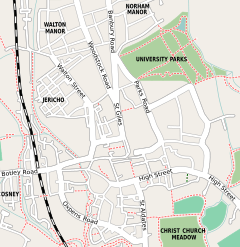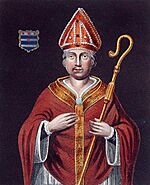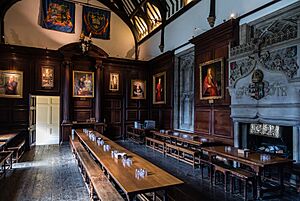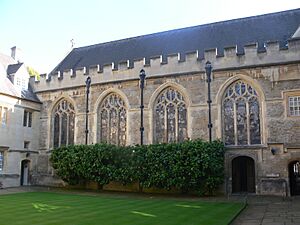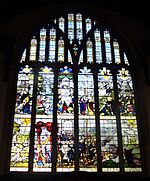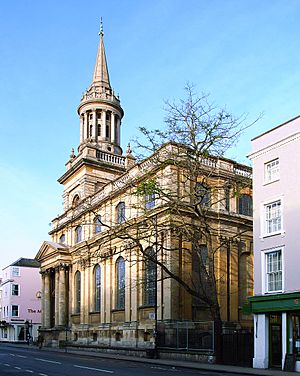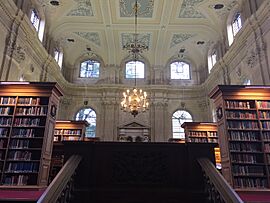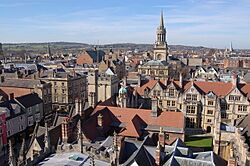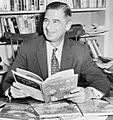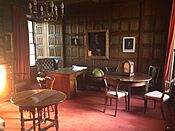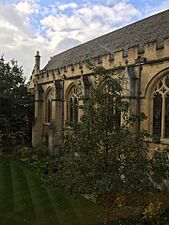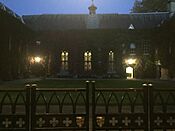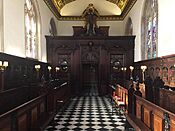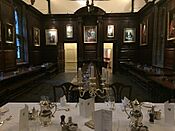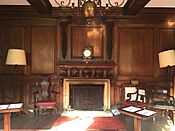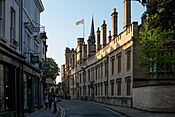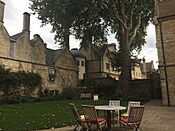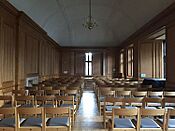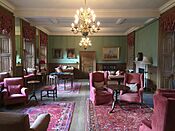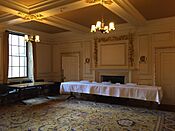Lincoln College, Oxford facts for kids
Quick facts for kids Lincoln College |
||||||||||||
|---|---|---|---|---|---|---|---|---|---|---|---|---|
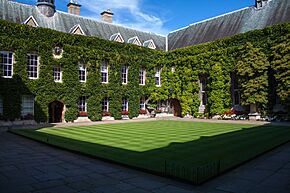 |
||||||||||||
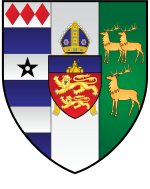
Blazon: see below
|
||||||||||||
|
|
||||||||||||
| University | University of Oxford | |||||||||||
| Location | Turl Street, Oxford OX1 3DR | |||||||||||
| Coordinates | 51°45′12″N 1°15′21″W / 51.75326°N 1.255905°W | |||||||||||
| Full name | The College of the Blessed Mary and All Saints, Lincoln | |||||||||||
| Latin name | Collegium Lincolniense | |||||||||||
| Established | 1427 | |||||||||||
| Named for | Richard Fleming (Bishop of Lincoln) | |||||||||||
| Sister college | Downing College, Cambridge | |||||||||||
| Rector | Prof. Henry Woudhuysen | |||||||||||
| Undergraduates | 308 (2011–12) | |||||||||||
| Postgraduates | 299 | |||||||||||
| Boat club | Boat Club website | |||||||||||
| Map | ||||||||||||
Lincoln College is a part of the University of Oxford in England. It is located on Turl Street in central Oxford. Lincoln College was started in 1427 by Richard Fleming, who was the Bishop of Lincoln at the time.
Many famous people have studied at Lincoln College. These include the doctor John Radcliffe, the founder of Methodism John Wesley, and scientists Howard Florey, Edward Abraham, and Norman Heatley who worked on antibiotics. Writers like Theodor Seuss Geisel (better known as Dr. Seuss) and David John Moore Cornwell (John le Carré) also went there. Other notable alumni include journalist Rachel Maddow, former British Prime Minister Rishi Sunak, and politician Shabana Mahmood. The international high-IQ society Mensa was also started at Lincoln College in 1946. Lincoln College is special because it has one of the oldest working medieval kitchens in the UK.
Contents
History of Lincoln College
How Was Lincoln College Started?
Richard Fleming, who was the Bishop of Lincoln, founded the college in 1427. He wanted to create a place for students to study theology. This was to help defend Christian teachings against new ideas from John Wyclif. King Henry VI gave him a special document called a charter for the college. This charter brought together three local churches under the college's care.
The college faced challenges early on. It did not have enough money, and there were wars happening at the time. However, the college survived thanks to its members and help from another Bishop of Lincoln, Thomas Rotherham. Richard Fleming died in 1431, and the college was still quite small. The second head of the college, John Beke, found new donors. By 1436, the college had seven fellows (senior members). John Forest gave a lot of money, which helped build a chapel, library, hall, and kitchen. Later, Bishop Thomas Rotherham also gave strong support, and the college was effectively re-founded in 1478.
The 18th Century and John Wesley
In the 1700s, Lincoln College became important for the start of Methodism. John Wesley, a fellow at the college from 1726, held religious meetings here. He met with his brother Charles and other students. They were called the 'Holy Club' and sometimes 'Bible-moths' by others at the university. John Wesley later became a missionary. He even signed his writings as "John Wesley, Sometime Fellow of Lincoln College." You can see his portrait in the college hall. A room where he worked is also named after him.
Friendly Rivalry with Brasenose College
Lincoln College has a long-standing friendly rivalry with its neighbor, Brasenose College. This rivalry is celebrated each year on Ascension Day. The story goes that a long time ago, a mob was chasing students. The Lincoln College gatekeeper let in Lincoln students but not a Brasenose student. This led to the Brasenose student's death. Another story says a Lincoln student won a duel against a Brasenose student.
Since then, Lincoln College invites Brasenose members through a special door connecting the two colleges. They offer them free beer as a way of saying sorry. Since the 1800s, the beer has been flavored with ivy. This is to make sure people don't drink too much!
Lincoln College Today
Lincoln College has a strong academic record. It has often been ranked among the top colleges at Oxford. For example, it ranked third in 2021 and second in 2022 in the Norrington Table. This table measures how well students perform in their exams.
In 1958, Lincoln College was the first college in Oxford or Cambridge to create a special common room for graduate students. This room is called the Middle Common Room. Like many Oxford colleges, Lincoln College started admitting both male and female students in 1979. Before that, it had been a college only for men for over 500 years.
The college also cares about the environment. In 2021, a special "Green Impact" team was formed. They have won an award from Oxford University for their efforts. They have also created a wild-flower garden near the library entrance to help local wildlife.
College Buildings
Lincoln College has kept much of its original 15th-century look. The front of the college and the main courtyard (called a quad) are still two stories high. The college also owns many buildings across Turl Street. These buildings are mainly used for student housing. The plant that covers the walls of the front quad is called Virginia creeper. It is dark green in summer and turns bright red in autumn.
The college has three main courtyards: the Front Quad (from the 1400s), the Chapel Quad (from the 1600s), and The Grove (from the 1800s). All the main college buildings are made of stone. The college bar, called Deep Hall or 'Deepers', is located under the main dining hall. It used to be the college's beer cellar. It is one of the oldest parts of the college. The wine cellar is also accessed through Deep Hall and goes under The Grove.
Lincoln College has been the setting for many books and TV shows. For example, parts of the TV series Inspector Morse and Lewis were filmed here.
The Chapel
The college chapel was built between 1629 and 1631. Its windows are very special. They are made using a technique called enameling. This means the glass is painted and then heated, making the colors permanent. These windows were created by Abraham van Linge, who was an expert in this method.
The east window shows twelve scenes from the Bible. The top six show events from Jesus' life, like the Last Supper. The bottom six show related scenes from the Old Testament, such as Adam and Eve at Creation. The north windows show the Twelve Prophets, and the south windows show the Twelve Apostles. The screen inside the chapel, which separates the main area from the organ, is made of cedar wood. It is said that the chapel smelled strongly of cedar for about 100 years after it was built.
Much of the chapel was repaired starting in 1999. The black slate and white marble floor tiles were fixed. The wooden parts, which had been damaged by moisture and worms, were also repaired. Cracks in the window enamel were fixed too. The goal was to keep the chapel's 17th-century look as much as possible.
The Library
The college's library is a very impressive building. It used to be All Saints Church, which was given to the college in 1971. The church tower is a famous part of Oxford's skyline. After the church spire fell down in 1700, a new church was designed. It is believed that parts of the tower and spire were designed by the famous architect Nicholas Hawksmoor. The tower has eight bells that are rung regularly.
The library holds about 60,000 books. Students can work there until late at night. The library is always adding new books and welcomes suggestions from students. The upper reading room has a beautiful decorated ceiling. The Senior Library downstairs holds older books, including writings from the English Civil War and plays from the 1600s and 1700s. There is also a small collection of old handwritten documents. The science library is also located downstairs.
Student Life at Lincoln College
Where Do Students Live?
Lincoln College promises all undergraduate students a place to live for three years. Most graduate students also get housing for their studies. The college has many places for students to live, all located in the city center. About 50 students live in the three main courtyards. Over 100 more live in rooms above shops across Turl Street. These include the Mitre rooms, which used to be guest rooms for the Mitre Inn. The college has owned the Mitre Inn since the 1400s.
Lincoln House, built in 1939, is another building directly across from the college. There were once plans to build a bridge over Turl Street to connect it to the main college, but this never happened. More housing is available at Bear Lane, near High Street. The college also owns terraced houses on Museum Road, known as 'Mus Road'. The EPA Science Centre, named after Edward Abraham, was built behind them. It has apartment-style housing, teaching rooms, and the college's old records.
Junior Common Room (JCR)
Because Lincoln College is small, its Junior Common Room (JCR) is very important to student life. The JCR is a common room for undergraduate students. It has a TV, kitchen, vending machine, newspapers, and sofas. It is also the name of the group that represents the undergraduate students to the college and the wider university. All undergraduate students are automatically members of the JCR.
The JCR is run by a team of ten officers, led by the President. This team works to improve student life and facilities. There is also a larger JCR Committee with 42 members. Members of the JCR Committee are chosen by student vote. Shabana Mahmood, a Member of Parliament, was JCR president in 2000–2001. JCR meetings are held three times each term.
The JCR was started in 1854 as the Lincoln College Debating Society. It was renamed in 1919. In the past, the society provided tobacco and cigarettes to its members. Now, it provides tea and coffee in the JCR kitchen.
Middle Common Room (MCR)
The Lincoln MCR is the oldest graduate common room at Oxford, founded in 1960. It has about 350 graduate students each year. The MCR organizes many social events and sports activities throughout the year. The MCR is located in the Berrow Foundation Building, which was finished in 2016.
Famous People from Lincoln College
-
Peter Durack, former Attorney-General of Australia
-
Lord Florey, Nobel Prize-winning pharmacologist and physiologist
-
John le Carré, author
-
David Lewis, former leader of the New Democratic Party
-
Rachel Maddow, television host
-
Emily Mortimer, actress and screenwriter
-
John Radcliffe, physician
-
Dr. Seuss, author and illustrator
-
Edward Thomas, poet killed in action during the First World War
-
John Wesley, cleric and theologian
Many well-known people have studied at Lincoln College. They have gone on to careers in academics, business, politics, and sports. Some famous alumni include:
- John Radcliffe: A famous doctor. Many places in Oxford are named after him, like the Radcliffe Camera and the John Radcliffe Hospital.
- Howard Florey: Won the Nobel Prize in Physiology or Medicine in 1945 for his work on making penicillin in large amounts.
- Edward Abraham and Norman Heatley: Biochemists who also helped develop penicillin.
- Philip May: The husband of former Prime Minister Theresa May.
- Steph Cook: An Olympic gold medalist.
- John le Carré: A famous author.
- Rachel Maddow: A political commentator and author.
- Dr. Seuss: A beloved author and illustrator of children's books.
- Rishi Sunak: The current British Prime Minister.
- John Wesley: A theologian who founded Methodism.
From 1954 to 1972, the head of the college was Walter Fraser Oakeshott. He is famous for finding an important old manuscript of Sir Thomas Malory's Le Morte d'Arthur in 1934. Lincoln College's largest performance space is named after him.
The current head of Lincoln College is Henry Woudhuysen. He will retire at the end of the 2023/24 school year.
Lincoln College was the first college in Oxford (or Cambridge) to accept a Jewish Fellow (a senior member of the college). This was the philosopher Samuel Alexander in 1882.
The novelist John le Carré, who studied at Lincoln, later said that his fictional spy boss, George Smiley, was partly based on a former head of Lincoln College, Vivian H. H. Green.
In 1955, Paul Shuffrey, a former student, created a special fellowship in memory of his father, Leonard Shuffrey.
Between 1998 and 2002, four future members of Parliament studied at Lincoln at the same time: Rishi Sunak, Lee Rowley, Shabana Mahmood, and Charles Banner.
Princess Elisabeth of Belgium, who is next in line to the Belgian throne, started studying history and politics at Lincoln College in 2021.
Gallery
See also
 In Spanish: Lincoln College para niños
In Spanish: Lincoln College para niños


